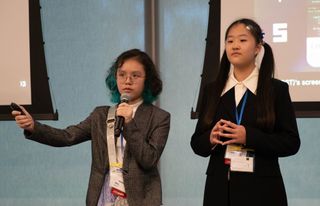We don’t need the computing power of a large language model to realize we’re not doing enough to teach girls about AI.
Women account for just 22% of the global AI workforce, according to the United Nations. But the good news is we know the formula for AI teaching success, say Tara Chklovski, Founder and CEO of Technovation, and Shanika Hope, Director of Tech Education at Google.
Technovation, a tech education nonprofit, recently partnered with Google, UNICEF, and other organizations to launch The AI Forward Alliance, which seeks to impact 25 million young women globally by providing them with evidence-based and actionable AI training. The program utilizes the Technovation curriculum, which is available free to educators globally.
“76% of girls who go through our program go into STEM degrees, and then go into STEM careers,” Chklovski says.
The training is built on four principles that are based on motivation theory. Chklovski and Hope discuss how these principles can be used to encourage AI success in girls anywhere in the world.
1. Teaching AI to Girls: Provide Relatable AI Role Models
One key step to getting girls interested in the field of AI is providing examples of successful women in the field.
“You need exposure to role models, people who look like you, who talk about the challenges that they overcame to get to where they are. That's critical,” Chklovski says.
“There are incredible entrepreneur women founders who are building incredible organizations and incredible AI technology themselves,” Hope says. “So helping girls to see them helps them to identify that they too can do this — can build and use and design incredible technology that scales and is solving problems that they care about in their community.”
Hope adds, “This requires us to be intentional about the kind of learning that we are putting in front of girls in terms of the curriculum being culturally responsive and reflecting them. Giving girls the opportunity to see girls in the curriculum in the learning, so that they see themselves tech and that their voice is included and that they're at the table.”
2. Incorporate Project-Based Learning
Having students work toward real-world goals is another key to successful AI education for girls.
“It starts really with this idea of learning by doing,” Hope says. “We just have to give girls the opportunity and the access to actually start using the tools, building the tools, designing the tools.”
In addition, assignments need to be something each student is passionate about. “It's not enough to just say, ‘Oh, here's how an AI model works, and then go do a project at the end.’ That never works,” Chklovski says. “The Technovation model is to find a problem that you care about in your community. And then, ‘Oh, by the way, here are the ways in which you can build an AI model or train a
